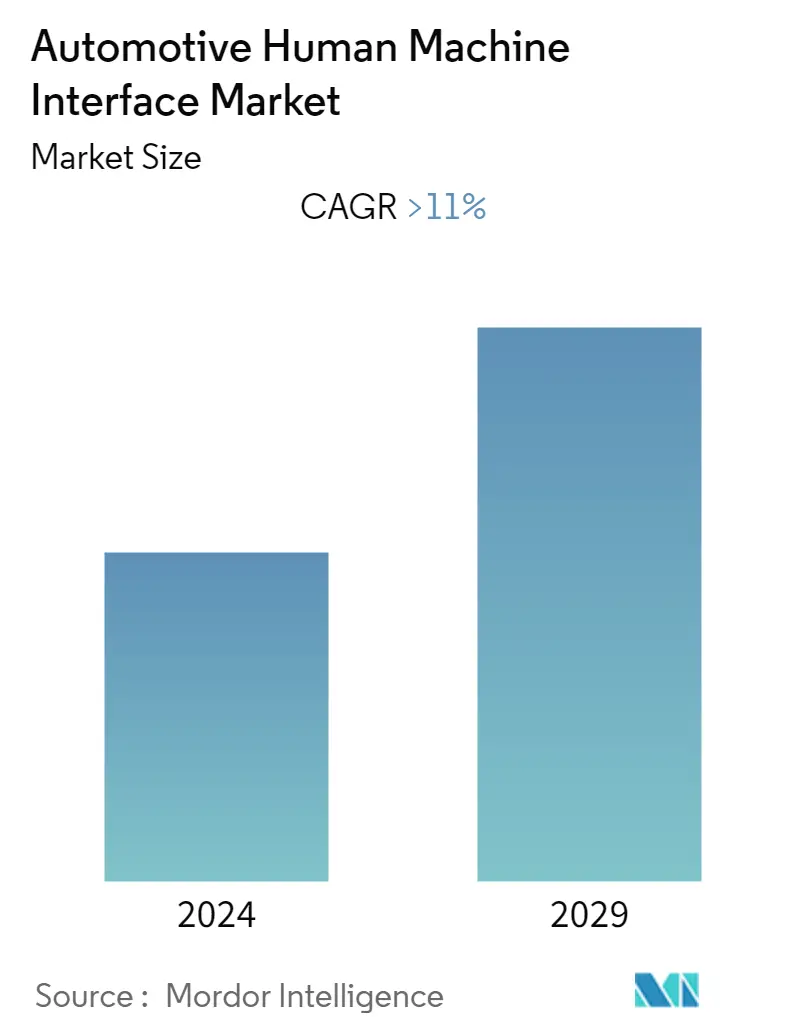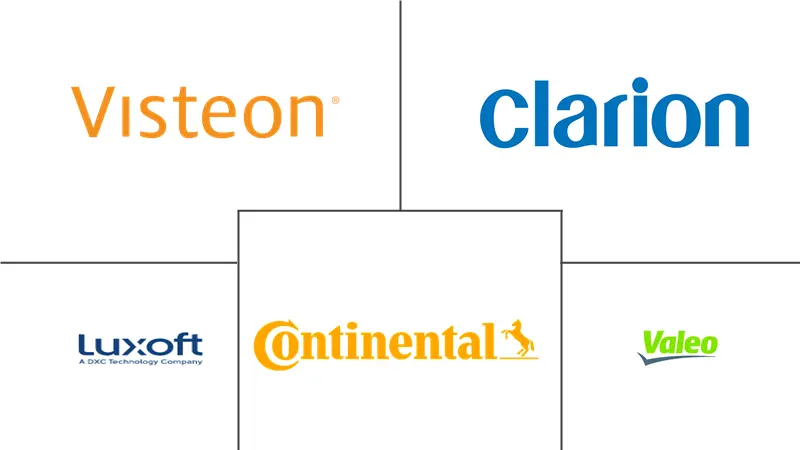Market Size of Automotive Human Machine Interface Industry

| Study Period | 2019 - 2029 |
| Base Year For Estimation | 2023 |
| CAGR | > 11.00 % |
| Fastest Growing Market | North America |
| Largest Market | North America |
| Market Concentration | Low |
Major Players
*Disclaimer: Major Players sorted in no particular order |
Automotive Human Machine Interface Market Analysis
The Automotive Human Machine Interface Market is projected to grow with a CAGR of more than 11% during the forecast period.
- The rapid incorporation of mobility and cloud technology in the automobile sector is enabling the provision of seamless on-the-go-experiences such as advanced navigation, connectivity, and smart safety. Moreover, the increased importance of the mass customization across car segments is driving the need for personalized solutions. The evolution of the connected vehicle market is expected to speed up the process and this will enhance the growth in Human Machine interface market.
- With an increase in global income levels of the people the people are demanding more and more enhanced user experience and entertainment systems in the vehicle. End users are emphasizing more on Advance Driver Assistance System (ADAS) and Human Machine Interface (HMI). These technologies provide great assistance while driving, finding routes, attending calls etc.
Automotive Human Machine Interface Industry Segmentation
The Automotive Human Machine Interface Market covers the latest trends and technological development in the Automotive HMI, demand of, product type (Voice Control System, Central Displays, Head-Up Displayes and Others), Vehicle type (Economy Passenger cars, Mid-Price Passenger cars and Luxury Passenger Cars) and Geography.
| Product Type | |
| Voice Control System | |
| Central Displays | |
| Heads-Up Display | |
| Others |
| Vehicle Type | |
| Economy Passenger Cars | |
| Mid-Price Passenger Cars | |
| Luxury Passenger Cars |
| Geography | |||||||
| |||||||
| |||||||
| |||||||
|
Automotive Human Machine Interface Market Size Summary
The Automotive Human Machine Interface (HMI) Market is experiencing significant growth, driven by the integration of mobility and cloud technologies in the automotive sector. This integration facilitates advanced navigation, connectivity, and smart safety features, catering to the increasing demand for personalized solutions across various car segments. The evolution of connected vehicles is further propelling the market, as consumers seek enhanced user experiences and entertainment systems. The emphasis on Advanced Driver Assistance Systems (ADAS) and HMI technologies is growing, as they offer substantial assistance in driving, navigation, and communication. However, the rising costs of advanced HMI systems pose challenges in major developing economies, where price sensitivity is high. This is particularly evident in countries like India, where government regulations have increased vehicle costs, making HMI systems more expensive compared to traditional analog instrument clusters.
Regionally, North America is poised to lead the market growth, benefiting from its early adoption of new technologies and a strong focus on research and development to enhance user experiences. Europe is expected to follow closely, driven by luxury and passenger car manufacturers investing heavily in technology to improve user comfort and experience. The market is characterized by fragmentation, with numerous players like Continental AG, Valeo S.A., and Visteon Corporation holding significant shares. These companies are actively investing in innovation and forming strategic partnerships to expand their market reach. Notable collaborations, such as those between Denso and Qualcomm, aim to develop next-generation cockpit systems, further fueling market expansion.
Automotive Human Machine Interface Market Size - Table of Contents
-
1. MARKET DYNAMICS
-
1.1 Market Drivers
-
1.2 Market Restraints
-
1.3 Porters Five Forces Analysis
-
1.3.1 Threat of New Entrants
-
1.3.2 Bargaining Power of Buyers/Consumers
-
1.3.3 Bargaining Power of Suppliers
-
1.3.4 Threat of Substitute Products
-
1.3.5 Intensity of Competitive Rivalry
-
-
-
2. MARKET SEGMENTATION
-
2.1 Product Type
-
2.1.1 Voice Control System
-
2.1.2 Central Displays
-
2.1.3 Heads-Up Display
-
2.1.4 Others
-
-
2.2 Vehicle Type
-
2.2.1 Economy Passenger Cars
-
2.2.2 Mid-Price Passenger Cars
-
2.2.3 Luxury Passenger Cars
-
-
2.3 Geography
-
2.3.1 North America
-
2.3.1.1 United States
-
2.3.1.2 Canada
-
2.3.1.3 Rest of North America
-
-
2.3.2 Europe
-
2.3.2.1 Germany
-
2.3.2.2 United Kingdom
-
2.3.2.3 France
-
2.3.2.4 Rest of Europe
-
-
2.3.3 Asia Pacific
-
2.3.3.1 India
-
2.3.3.2 China
-
2.3.3.3 Japan
-
2.3.3.4 South Korea
-
2.3.3.5 Rest of Asia-Pacific
-
-
2.3.4 Rest of the World
-
2.3.4.1 Brazil
-
2.3.4.2 Mexico
-
2.3.4.3 United Arab Emirates
-
2.3.4.4 Other Countries
-
-
-
Automotive Human Machine Interface Market Size FAQs
What is the current Automotive Human Machine Interface Market size?
The Automotive Human Machine Interface Market is projected to register a CAGR of greater than 11% during the forecast period (2024-2029)
Who are the key players in Automotive Human Machine Interface Market?
Continental AG, Visteon Corporation, Luxoft technology, Valeo S.A. and Clairion Co. Ltd. are the major companies operating in the Automotive Human Machine Interface Market.

